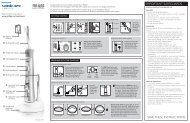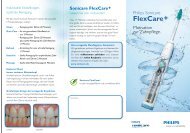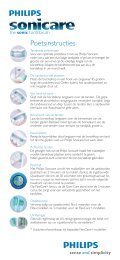Philips Sonicare FlexCare - Sonicare.com - Sonicare
Philips Sonicare FlexCare - Sonicare.com - Sonicare
Philips Sonicare FlexCare - Sonicare.com - Sonicare
Create successful ePaper yourself
Turn your PDF publications into a flip-book with our unique Google optimized e-Paper software.
Table 4—Change in number of bleeding sites after 2 and 4 weeks<br />
Parameter<br />
P value is from ANCOVA.<br />
SD = standard deviation; ANCOVA = analysis of covariance.<br />
N<br />
Baseline<br />
Sites<br />
2 Weeks<br />
Change in sites<br />
4 Weeks<br />
Change in sites<br />
<strong>FlexCare</strong> 87 44.72 ± 12.35 -24.07 ± 9.15 -31.59 ± 9.33<br />
Oral-B P40 88 41.85 ± 11.91 -21.80 ± 7.57 -27.89 ± 9.06<br />
P value .324 .029<br />
tions at each visit and review of subject-reported<br />
adverse events demonstrated the safety of the tested<br />
products with respect to hard and soft tissues.<br />
Discussion<br />
The results from this 4-week clinical trial<br />
demonstrate a strong effect of the <strong>FlexCare</strong> on reducing<br />
plaque-induced gingival inflammation. This<br />
was reflected in a highly significant reduction of GI<br />
scores after 2 and 4 weeks of use. The positive out<strong>com</strong>e<br />
corroborates results obtained in similar studies<br />
conducted with other sonic toothbrushes. 16-18 It was<br />
further substantiated by significantly reduced PI<br />
scores and a drop in the number of bleeding sites by<br />
70.6% over the 4-week period. Reductions in GI and<br />
PI scores were 28.4% and 43.9%, respectively, and<br />
associated score reductions between baseline and<br />
visit 3 were statistically significant. The results<br />
achieved with <strong>FlexCare</strong> clearly exceeded the efficacy<br />
thresholds of 15% for GI and statistical significance<br />
for PI established by the American Dental Association<br />
Acceptance Program 19 for power toothbrushes.<br />
This study also demonstrates that <strong>FlexCare</strong><br />
offers statistically significantly greater plaque<br />
removal ability than a manual toothbrush. The<br />
observed treatment effect of 3.9% probably underestimated<br />
the true advantage that could be expected<br />
from using the <strong>FlexCare</strong> in a nontrial situation. For<br />
instance, all manual toothbrush users reported<br />
excellent <strong>com</strong>pliance with instructions for brushing<br />
Figure 2—Number of gingival sites with GI score ≥2.0 at baseline (bleeding sites) by treatment group<br />
45<br />
40<br />
<strong>FlexCare</strong><br />
MTB<br />
35<br />
30<br />
Number<br />
of bleeding<br />
sites<br />
25<br />
20<br />
P = .324<br />
P = .029<br />
15<br />
10<br />
5<br />
0<br />
Baseline Week 2 Week 4<br />
Weeks of product use<br />
P values were calculated from ANCOVA adjusted for baseline differences.<br />
GI = gingival index; MTB = manual toothbrush; ANCOVA = analysis of covariance.<br />
Vol. 28, No. 9 (Suppl 1) Compendium / September 2007<br />
39










